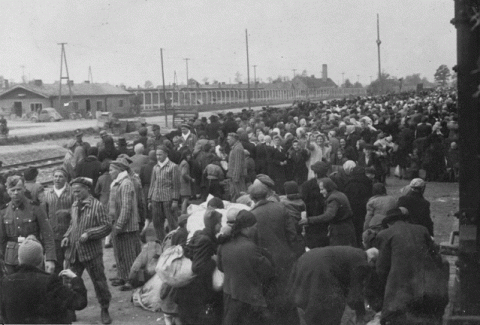Hungarian Deportation: An Objectivity Lesson
By Carolyn Yeager
For a lesson in objectivity, let's compare this photograph of real Hungarians arriving at Auschwitz-Birkenau, and meeting real German officers, guards and kapos [enlarge] ...
...with this sketch of a similar scene that was presented to the public by the Auschwitz Memorial Museum in Poland in January of this year.

They expect us to believe it was "taken from a unique sketchbook drawn around 1943 at the Birkenau camp by a prisoner who hid it in a bottle." Further explanation is that "a former prisoner [unnamed] working as a watchman discovered the 32 sketches in a bottle near the death camp's crematorium in 1947." He found it in 1947? Yet it was only January 2012 that they published these drawings in a book they titled "The Sketchbook from Auschwitz?" It includes 22 pages of drawings from this "unknown prisoner whose initials were apparently MM."
Museum spokesman Pawel Sawicki told Spiegel Online, "These sketches are the only work of art made in Birkenau that depict exterminations." Gee whiz, "work of art" must include photographs because there are none of those either! Are they subtly trying to equate drawings with photographs by this kind of wording? We must suspect they are.
The museum art historian Agnieszka Sieradzka wrote in the book, "You can clearly see that the author was determined to present the largest number of details. Badges of functionary prisoners, number plates of trucks, train cars on the ramp as well as block numbers are carefully depicted." Sure, "the artist" was copying all the photos that were available, but adding "his" own extra details--such as the rifles held by all the soldiers, which are not in the above photograph. There are no kapos or prisoner-workers in striped clothing in the drawing, only SS men. The new arrivals are all wearing Star of David badges, of which we do not see a single one in the photograph. They are dressed like well-to-do city folk in suits and hats, whereas the photograph shows the women's heads covered with "babushkas" (scarfs) and the men in caps or the Orthodox black hats.
In the photograph the arrivees are talking to the soldiers without fear while the sketch shows only soldiers, with their SS lapels carefully detailed, pointing guns or shouting orders.In other words, the sketch might show the details of the train, the towers, the uniforms--but not the true way the people actually looked and dressed, nor how they were treated. That last part is all comic book-type fantasy taken from fictional books like Elie Wiesel's Night. There is even a drawing of a "crematorium building" showing red-colored fire and heavy smoke coming out of the double chimneys. We know no one actually saw that! The no-doubt-modern-day-artist had a field day dreaming up as much anti-German meanness and Jewish humiliation he or she could without regard to the facts of science and technology.
We are told that this publication issued on Jan. 16 is part of a larger commemorative project being undertaken by the museum to mark this year's 70th anniversary for what they call the "beginning of the extermination program" at the camp. The Auschwitz-Birkenau Memorial Museum has become a big money-maker for the state of Poland via tourism, and secures substantial employment for Poles far beyond jobs as tour guides and grounds-keepers. Poland has become more aggressive, therefore, in upgrading their lucrative tourist attraction and eagerly works with European and American Jews and Israel to keep Auschwitz a going concern far into the future.
- 4750 reads










